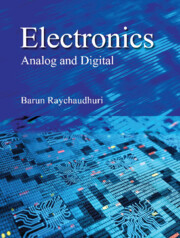Refine search
Actions for selected content:
1784 results in Circuits and systems
6 - Advanced Comparator Concepts
-
- Book:
- Analysis and Design of Data Converters
- Published online:
- 13 November 2025
- Print publication:
- 03 July 2025, pp 102-128
-
- Chapter
- Export citation
Dedication
-
- Book:
- Analysis and Design of Data Converters
- Published online:
- 13 November 2025
- Print publication:
- 03 July 2025, pp v-vi
-
- Chapter
- Export citation
Frontmatter
-
- Book:
- Analysis and Design of Data Converters
- Published online:
- 13 November 2025
- Print publication:
- 03 July 2025, pp i-iv
-
- Chapter
- Export citation
11 - Capacitor DACs
-
- Book:
- Analysis and Design of Data Converters
- Published online:
- 13 November 2025
- Print publication:
- 03 July 2025, pp 210-235
-
- Chapter
- Export citation
14 - SAR ADC Fundamentals
-
- Book:
- Analysis and Design of Data Converters
- Published online:
- 13 November 2025
- Print publication:
- 03 July 2025, pp 284-309
-
- Chapter
- Export citation
1 - Introduction to Data Conversion
-
- Book:
- Analysis and Design of Data Converters
- Published online:
- 13 November 2025
- Print publication:
- 03 July 2025, pp 1-5
-
- Chapter
- Export citation
16 - Advanced SAR ADCs
-
- Book:
- Analysis and Design of Data Converters
- Published online:
- 13 November 2025
- Print publication:
- 03 July 2025, pp 330-352
-
- Chapter
- Export citation
5 - Comparator Design Principles
-
- Book:
- Analysis and Design of Data Converters
- Published online:
- 13 November 2025
- Print publication:
- 03 July 2025, pp 70-101
-
- Chapter
- Export citation
9 - Resistor-Ladder DACs
-
- Book:
- Analysis and Design of Data Converters
- Published online:
- 13 November 2025
- Print publication:
- 03 July 2025, pp 158-173
-
- Chapter
- Export citation
Index
-
- Book:
- Analysis and Design of Data Converters
- Published online:
- 13 November 2025
- Print publication:
- 03 July 2025, pp 582-586
-
- Chapter
- Export citation
Acknowledgments
-
- Book:
- Analysis and Design of Data Converters
- Published online:
- 13 November 2025
- Print publication:
- 03 July 2025, pp xvi-xvii
-
- Chapter
- Export citation
3 - Sampling Circuits
-
- Book:
- Analysis and Design of Data Converters
- Published online:
- 13 November 2025
- Print publication:
- 03 July 2025, pp 20-59
-
- Chapter
- Export citation
23 - Nonidealities in ΔΣ Modulators
-
- Book:
- Analysis and Design of Data Converters
- Published online:
- 13 November 2025
- Print publication:
- 03 July 2025, pp 534-558
-
- Chapter
- Export citation
19 - Advanced SAR and Pipelining Techniques
-
- Book:
- Analysis and Design of Data Converters
- Published online:
- 13 November 2025
- Print publication:
- 03 July 2025, pp 418-438
-
- Chapter
- Export citation
2 - Basic Circuit Concepts
-
- Book:
- Analysis and Design of Data Converters
- Published online:
- 13 November 2025
- Print publication:
- 03 July 2025, pp 6-19
-
- Chapter
- Export citation
Preface
-
- Book:
- Analysis and Design of Data Converters
- Published online:
- 13 November 2025
- Print publication:
- 03 July 2025, pp xv-xv
-
- Chapter
- Export citation

Basic Electronics
- Principles and Applications
-
- Published online:
- 03 June 2025
- Print publication:
- 01 March 2018
-
- Textbook
- Export citation

Electronics
- Analog and Digital
-
- Published online:
- 30 April 2025
- Print publication:
- 15 June 2023
-
- Textbook
- Export citation
6N - Op-Amps I
- from Part III - Analog: Operational Amplifiers and their Applications
-
- Book:
- Learning the Art of Electronics
- Published online:
- 18 March 2025
- Print publication:
- 03 April 2025, pp 263-279
-
- Chapter
- Export citation
28N - Project Possibilities: Toys in the Attic
- from Part VI - Microcontrollers
-
- Book:
- Learning the Art of Electronics
- Published online:
- 18 March 2025
- Print publication:
- 03 April 2025, pp 1087-1110
-
- Chapter
- Export citation
